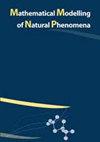Optimal Control Strategy to Control Pandemic COVID-19 Using MSI_LI_HR_V Model
IF 2.1
4区 数学
Q2 MATHEMATICAL & COMPUTATIONAL BIOLOGY
引用次数: 0
Abstract
Many researchers began doing studies about pandemic COVID-19 which began to spread from Wuhan, China in 2019 to all around the world and so far, numerous researches have been done around the world to control this contagious disease. In this paper, we proposed mathematical model to study the spreading of pandemic COVID-19. This paper is aimed to study the vaccination effect in the control of the disease propagation rate. Another goal of this paper is to find the maximum number of susceptible people, minimum number of infected people, and the best value for number of vaccination people. The Jacobin matrix was obtained in the virus absenteeism equilibrium point for the proposed dynamical system. The spectral radius method was applied to find the analytical formula for the reproductive number. Reproductive number is one of the most benefit and important tools to study of epidemic model’s stability and unstability. In the following, by adding a controller to the model and also using the optimal control strategy, model performance was improved. To validate of the proposed models with controller and without controller we use the real data of Covid-19 from 4 Jan, 2021 up to 14 June, 2021 in Iran.基于MSI_LI_HR_V模型的大流行COVID-19最优控制策略
许多研究人员开始对2019年从中国武汉开始传播到世界各地的COVID-19大流行进行研究,到目前为止,世界各地已经做了许多研究来控制这种传染病。本文提出了研究COVID-19大流行传播的数学模型。本文旨在研究疫苗接种对病害传播速度的控制效果。本文的另一个目标是找到最大易感人数、最小感染人数和接种人数的最佳值。在病毒缺勤平衡点处得到了该动态系统的雅可比矩阵。应用谱半径法求出繁殖数的解析公式。繁殖数是研究传染病模型稳定性和不稳定性的最有利和重要的工具之一。接下来,通过在模型中加入控制器并采用最优控制策略,提高了模型的性能。为了验证提出的有控制器和无控制器模型,我们使用了2021年1月4日至2021年6月14日在伊朗的Covid-19真实数据。
本文章由计算机程序翻译,如有差异,请以英文原文为准。
求助全文
约1分钟内获得全文
求助全文
来源期刊

Mathematical Modelling of Natural Phenomena
MATHEMATICAL & COMPUTATIONAL BIOLOGY-MATHEMATICS, INTERDISCIPLINARY APPLICATIONS
CiteScore
5.20
自引率
0.00%
发文量
46
审稿时长
6-12 weeks
期刊介绍:
The Mathematical Modelling of Natural Phenomena (MMNP) is an international research journal, which publishes top-level original and review papers, short communications and proceedings on mathematical modelling in biology, medicine, chemistry, physics, and other areas. The scope of the journal is devoted to mathematical modelling with sufficiently advanced model, and the works studying mainly the existence and stability of stationary points of ODE systems are not considered. The scope of the journal also includes applied mathematics and mathematical analysis in the context of its applications to the real world problems. The journal is essentially functioning on the basis of topical issues representing active areas of research. Each topical issue has its own editorial board. The authors are invited to submit papers to the announced issues or to suggest new issues.
Journal publishes research articles and reviews within the whole field of mathematical modelling, and it will continue to provide information on the latest trends and developments in this ever-expanding subject.
 求助内容:
求助内容: 应助结果提醒方式:
应助结果提醒方式:


